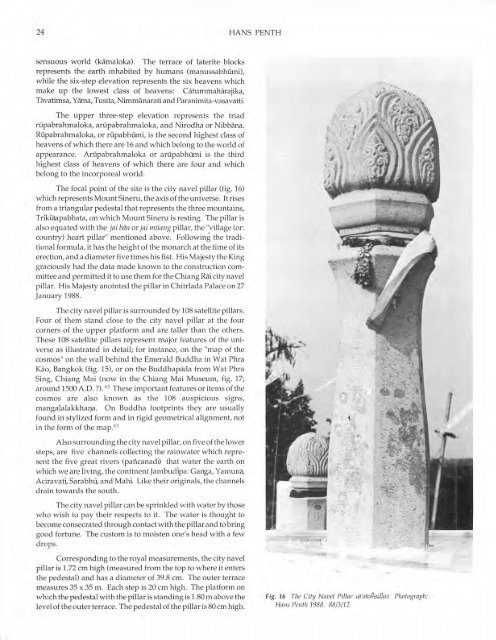The Journal of the Siam Society Vol. LXXVII, Part 1-2, 1989 - Khamkoo
The Journal of the Siam Society Vol. LXXVII, Part 1-2, 1989 - Khamkoo
The Journal of the Siam Society Vol. LXXVII, Part 1-2, 1989 - Khamkoo
Create successful ePaper yourself
Turn your PDF publications into a flip-book with our unique Google optimized e-Paper software.
24 HANS PENTH<br />
sensuous world (kamaloka). <strong>The</strong> terrace <strong>of</strong> laterite blocks<br />
represents <strong>the</strong> earth inhabited by humans (manussabhumi),<br />
w hile <strong>the</strong> six-step elevation represents <strong>the</strong> six heavens which<br />
make up <strong>the</strong> lowest class <strong>of</strong> heavens: Catummaharajika,<br />
Tavatimsa, Yama, Tusita, Ni.mmanarati and Paranimita-vasavatti.<br />
<strong>The</strong> upper three-step elevation represents <strong>the</strong> triad<br />
rl!pabrahmaloka, arupabrahmaloka, and N irodha or Nibbana.<br />
Rl!pabrahmaloka, or rt:tpabhilini, is <strong>the</strong> second highest class <strong>of</strong><br />
heavens <strong>of</strong> which <strong>the</strong>re are 16 and w hich belong to <strong>the</strong> world <strong>of</strong><br />
appearance. Arl!pabrahmaloka or anlpabht:m1i is <strong>the</strong> third<br />
highest class <strong>of</strong> heavens <strong>of</strong> which <strong>the</strong>re are four and which<br />
belong to <strong>the</strong> incorporeal world.<br />
<strong>The</strong> focal point <strong>of</strong> <strong>the</strong> site is <strong>the</strong> city navel pillar (fig. 16)<br />
w_hich represents Mount Sineru, <strong>the</strong> axis <strong>of</strong> <strong>the</strong> universe. It rises<br />
from a triangular pedestal that represents <strong>the</strong> three mountains,<br />
Trlkl!tapabbata, on w hich Mount Sineru is resting. <strong>The</strong> pillar is<br />
also equated with <strong>the</strong> jai ban or jai miiang pillar, <strong>the</strong> "village (or:<br />
country) hea rt pilla r" mentioned above. Following <strong>the</strong> traditional<br />
formula, it has <strong>the</strong> height <strong>of</strong> <strong>the</strong> monarch at <strong>the</strong> time <strong>of</strong> its<br />
erection, and a diameter five times his fist. His Majesty <strong>the</strong> King<br />
graciously had <strong>the</strong> data made known to <strong>the</strong> construction committee<br />
and permitted it to use <strong>the</strong>m for <strong>the</strong> Chiang Rai city navel<br />
pillar. His Majesty anointed <strong>the</strong> pillar in Chitrlada Palace on 27<br />
January 1988.<br />
<strong>The</strong> city navel pillar is surrounded by 108 satellite pillars.<br />
Four <strong>of</strong> <strong>the</strong>m stand cl ose to <strong>the</strong> city navel pillar at <strong>the</strong> four<br />
corners <strong>of</strong> <strong>the</strong> upper platform and are taller than <strong>the</strong> o<strong>the</strong>rs.<br />
<strong>The</strong>se 108 sa tellite pillars represent major features <strong>of</strong> <strong>the</strong> universe<br />
as illustrated in detail; for instance, on <strong>the</strong> "map <strong>of</strong> <strong>the</strong><br />
cosmos" on <strong>the</strong> wall behind <strong>the</strong> Emerald Buddha in Wat Phra<br />
Kao, Bangkok (fig. 15), or on <strong>the</strong> Buddhapada from Wat Phra<br />
Sing, Chiang Mai (now in <strong>the</strong> Chiang Mai Museum, fi g. 17;<br />
around 1500 A.D.?). H 2 <strong>The</strong>se important fea tures or items <strong>of</strong> <strong>the</strong><br />
cosmos are also known as <strong>the</strong> 108 auspicious signs,<br />
mangalalakkhai}a. On Buddha footprints <strong>the</strong>y are usually<br />
found in stylized form and in rigid geometrical alignment, not<br />
in <strong>the</strong> form <strong>of</strong> <strong>the</strong> ma p H 3<br />
Also surrounding <strong>the</strong> city navel pillar, on five <strong>of</strong> <strong>the</strong> lower<br />
steps, are five channels collecting <strong>the</strong> rainwater which represent<br />
<strong>the</strong> fi ve grea t rivers (pancanad]) that water <strong>the</strong> earth on<br />
which we are living, <strong>the</strong> continent Jambudipa: Gmiga, Yamuna,<br />
Aciravatl, Sarabhu, and Mahl. Like <strong>the</strong>ir originals, <strong>the</strong> channels<br />
drain towards <strong>the</strong> south.<br />
<strong>The</strong> city navel pillar ca n be sprinkled w ith water by those<br />
w ho wish to pay <strong>the</strong>ir respects to it. <strong>The</strong> water is thought to<br />
become consecrated through contact with <strong>the</strong> pillar and to bring<br />
good fortune. <strong>The</strong> custom is to moisten one's head with a few<br />
drops.<br />
Corresponding to <strong>the</strong> royal measurements, <strong>the</strong> ci ty navel<br />
pillar is 1.72 em high (measured from <strong>the</strong> top to where it enters<br />
<strong>the</strong> pedestal) and has a diameter <strong>of</strong> 39.8 em. <strong>The</strong> outer terrace<br />
measures 35 x 35 m . Each step is 20 em high. <strong>The</strong> platform on<br />
which <strong>the</strong> ped estal with <strong>the</strong> pillar is standing is 1.80 m above <strong>the</strong><br />
level <strong>of</strong> <strong>the</strong> outer terrace. <strong>The</strong> ped estal <strong>of</strong> <strong>the</strong> pillar is 80 em high.<br />
Fig. 16 Th e City Navel Pillar 'fl1ff::~vd1vJ.<br />
Han s Pen/11 1988. 88/3/12<br />
Photogmph:

















